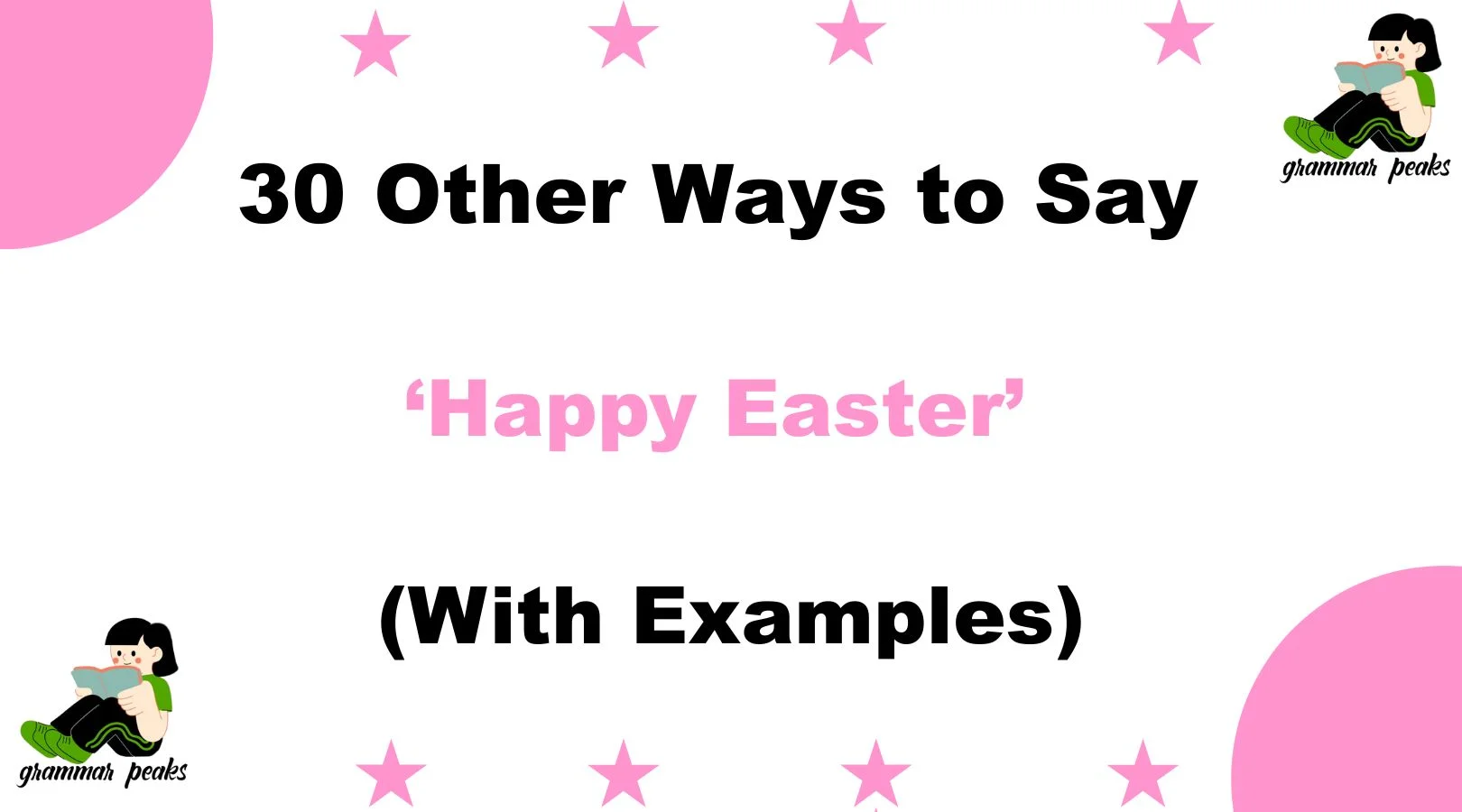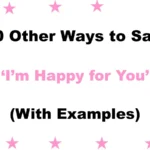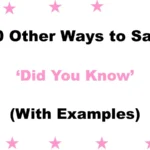Expressing heartfelt wishes during special occasions like Easter is truly meaningful. Choosing the right words can deepen the connection between you and the person receiving your message. Instead of a simple “Happy Easter,” exploring different ways to say it allows you to bring warmth, creativity, and personal touch to your greetings.
Whether you want to sound formal, casual, or playful, these 30 alternatives will help you communicate your care thoughtfully and with empathy. This article will guide you through each phrase, explaining when and how to use them for maximum impact. Let’s make your Easter wishes stand out with sincere and memorable expressions!
What Does “Happy Easter” Mean?
The phrase “Happy Easter” is a traditional greeting used to celebrate Easter, a Christian holiday commemorating the resurrection of Jesus Christ. It conveys joy, hope, and blessings during this festive season. Saying “Happy Easter” is a way to share positive feelings and goodwill with family, friends, and acquaintances. It is a simple yet powerful expression of celebration and care that resonates deeply during the holiday.
When to Use “Happy Easter”
Use “Happy Easter” during the Easter season when greeting others in person, in cards, messages, or social media posts. It’s suitable for both formal and informal situations. However, depending on the relationship or tone you want to set, you might prefer alternative phrases that add more warmth, faith, humor, or creativity to your message.
Is It Professional/Polite to Say “Happy Easter”?
Yes, saying “Happy Easter” is generally polite and acceptable in most professional and social contexts, especially where Easter is celebrated culturally or religiously. However, in highly diverse or secular environments, it’s wise to be considerate of others’ beliefs and perhaps use more neutral or inclusive greetings.
Pros and Cons of Using “Happy Easter”
Pros:
- Clearly acknowledges the holiday.
- Friendly and universally understood.
- Suitable for a wide audience.
Cons:
- Can feel generic or impersonal.
- May not suit all cultural or religious backgrounds.
- Limits emotional or creative expression.
Synonyms for “Happy Easter”
- Joyful Easter Wishes
- Blessed Easter to You
- Easter Blessings
- Wishing You a Joyous Easter
- Have a Beautiful Easter
- Easter Greetings
- Celebrate This Blessed Easter
- Wishing You Renewal and Joy
- Hoping Your Easter is Bright
- Sending Easter Cheer Your Way
- Warm Easter Wishes
- Peaceful Easter to You
- Easter Happiness to You and Yours
- Springtime Blessings
- Wishing You Easter Joy and Love
- Rejoice This Easter
- Bright Easter Blessings
- Enjoy a Hopeful Easter
- May Your Easter Be Full of Grace
- He Is Risen! Happy Easter
- Sending You Easter Smiles
- Have a Blessed and Happy Easter
- Wishing You an Easter Filled With Love
- Hope Your Easter is Egg-stra Special
- Enjoy the Joy of Easter
- Easter Wishes Full of Sunshine
- Blessings of Hope This Easter
- A Joyous and Blessed Easter to You
- Wishing You Easter Peace and Joy
- Celebrate Easter With a Happy Heart
1. Joyful Easter Wishes
Definition: A warm greeting expressing happiness and celebration during Easter.
Detailed Explanation: This phrase emphasizes the joyfulness associated with Easter. It focuses on the emotional delight the holiday brings.
Scenario Examples: Sending a card to close friends or family.
Best Use: Informal to semi-formal settings where you want to emphasize happiness.
Worst Use: Too casual for very formal or religious ceremonies.
Tone: Warm, cheerful, uplifting.
2. Blessed Easter to You
Definition: A wish for spiritual blessings during Easter.
Detailed Explanation: Highlights the religious significance of Easter and offers blessings.
Scenario Examples: Church community, religious acquaintances.
Best Use: Religious or faith-centered communications.
Worst Use: May not resonate with secular audiences.
Tone: Reverent, caring, sincere.
3. Easter Blessings
Definition: A simple yet meaningful phrase focusing on blessings.
Detailed Explanation: Offers goodwill and divine favor to the recipient.
Scenario Examples: Easter cards, church bulletins.
Best Use: Semi-formal or formal messages.
Worst Use: Too brief for casual conversations.
Tone: Respectful, spiritual, heartfelt.
4. Wishing You a Joyous Easter
Definition: A more descriptive way to wish happiness for Easter.
Detailed Explanation: Expands on “Happy Easter” by explicitly wishing joy.
Scenario Examples: Emails, greeting cards, social media posts.
Best Use: When you want a polished yet heartfelt tone.
Worst Use: May sound stiff if used too informally.
Tone: Polite, joyful, thoughtful.
5. Have a Beautiful Easter
Definition: A warm, picturesque wish for the holiday.
Detailed Explanation: Suggests a serene and lovely Easter experience.
Scenario Examples: Personal notes, messages to friends.
Best Use: Informal, friendly exchanges.
Worst Use: May be too vague for formal religious messages.
Tone: Gentle, warm, affectionate.
6. Easter Greetings
Definition: A neutral, all-purpose greeting.
Detailed Explanation: Suitable for any audience, simple and clear.
Scenario Examples: Business emails, group cards.
Best Use: Professional or diverse groups.
Worst Use: May feel impersonal in close relationships.
Tone: Formal, polite, neutral.
7. Celebrate This Blessed Easter
Definition: Encouragement to joyfully honor the holiday.
Detailed Explanation: Combines celebration with acknowledgment of spiritual blessings.
Scenario Examples: Church newsletters, community messages.
Best Use: Religious and community settings.
Worst Use: Might be too formal or religious for some.
Tone: Joyful, reverent, inviting.
8. Wishing You Renewal and Joy
Definition: A wish highlighting Easter themes of renewal and happiness.
Detailed Explanation: Reflects on the symbolic meaning of rebirth and new beginnings.
Scenario Examples: Close friends, family, or spiritual groups.
Best Use: Personal, meaningful exchanges.
Worst Use: Could feel abstract in casual chats.
Tone: Hopeful, warm, meaningful.
9. Hoping Your Easter is Bright
Definition: A cheerful wish for a lively and happy holiday.
Detailed Explanation: Uses “bright” to evoke positivity and light.
Scenario Examples: Friendly messages, social media.
Best Use: Casual and upbeat communications.
Worst Use: Not suitable for very formal settings.
Tone: Playful, lighthearted, friendly.
10. Sending Easter Cheer Your Way
Definition: Expressing the intent to share happiness and good vibes.
Detailed Explanation: Informal phrase focusing on joyful spirit.
Scenario Examples: Text messages, informal cards.
Best Use: Friends, family, casual colleagues.
Worst Use: Not for formal or religious contexts.
Tone: Friendly, cheerful, casual.
11. Warm Easter Wishes
Definition: A sincere greeting with a comforting tone.
Detailed Explanation: Emphasizes warmth and kindness in the greeting.
Scenario Examples: Professional emails, acquaintances.
Best Use: Polite but not overly formal.
Worst Use: Could feel generic with close friends.
Tone: Kind, sincere, gentle.
12. Peaceful Easter to You
Definition: A wish focused on tranquility and calmness.
Detailed Explanation: Highlights the peaceful nature of the holiday.
Scenario Examples: Spiritual communities, quiet reflection.
Best Use: Those seeking calm or healing.
Worst Use: Might seem dull in lively celebrations.
Tone: Calm, serene, thoughtful.
13. Easter Happiness to You and Yours
Definition: A greeting extending joy to the recipient and their family.
Detailed Explanation: Emphasizes communal joy and togetherness.
Scenario Examples: Family cards, group messages.
Best Use: Family, close friends, groups.
Worst Use: Too informal for business settings.
Tone: Warm, inclusive, joyful
14. Springtime Blessings
Definition: A seasonal greeting linked to Easter’s timing.
Detailed Explanation: Connects Easter to the renewal of spring.
Scenario Examples: Nature lovers, garden clubs.
Best Use: Informal, creative expressions.
Worst Use: Not focused enough on Easter itself for some.
Tone: Fresh, hopeful, natural.
15. Wishing You Easter Joy and Love
Definition: A heartfelt wish combining two powerful emotions.
Detailed Explanation: Expresses deep care and happiness.
Scenario Examples: Romantic partners, family members.
Best Use: Close relationships.
Worst Use: May seem too intimate in formal contexts.
Tone: Loving, sincere, heartfelt.
16. Rejoice This Easter
Definition: A call to celebrate joyfully.
Detailed Explanation: Invites active participation in the holiday spirit.
Scenario Examples: Church services, community events.
Best Use: Religious or communal gatherings.
Worst Use: Too formal for casual chats.
Tone: Uplifting, energetic, spiritual.
17. Bright Easter Blessings
Definition: Combining brightness with spiritual blessings.
Detailed Explanation: Suggests hope and favor during Easter.
Scenario Examples: Cards, emails.
Best Use: Semi-formal communications.
Worst Use: Could feel abstract in casual settings.
Tone: Positive, hopeful, warm.
18. Enjoy a Hopeful Easter
Definition: Encourages optimism and positivity.
Detailed Explanation: Highlights Easter’s theme of hope.
Scenario Examples: Personal messages, encouragement cards.
Best Use: Those going through challenges.
Worst Use: Might seem generic in celebrations.
Tone: Encouraging, gentle, optimistic.
19. May Your Easter Be Full of Grace
Definition: A spiritual wish for elegance and divine favor.
Detailed Explanation: Focuses on grace as a blessing.
Scenario Examples: Religious friends, church members.
Best Use: Faith-based contexts.
Worst Use: Could be too formal for casual settings.
Tone: Reverent, sincere, respectful.
20. He Is Risen! Happy Easter
Definition: A traditional Christian proclamation with a greeting.
Detailed Explanation: Directly acknowledges the resurrection of Christ.
Scenario Examples: Church greetings, religious cards.
Best Use: Devout Christian audiences.
Worst Use: Not for secular or interfaith contexts.
Tone: Joyful, faith-filled, celebratory.
21. Sending You Easter Smiles
Definition: A playful, friendly greeting.
Detailed Explanation: Focuses on spreading happiness visually and emotionally.
Scenario Examples: Children, friends.
Best Use: Informal, casual greetings.
Worst Use: Too casual for professional use.
Tone: Cheerful, light, fun.
22. Have a Blessed and Happy Easter
Definition: Combines blessings and happiness in one greeting.
Detailed Explanation: Offers a comprehensive, heartfelt wish.
Scenario Examples: Family, friends, colleagues.
Best Use: Versatile, all-around use.
Worst Use: None significant.
Tone: Warm, sincere, inclusive.
23. Wishing You an Easter Filled With Love
Definition: Focuses on love as the central theme.
Detailed Explanation: Emphasizes emotional connection and affection.
Scenario Examples: Close relationships.
Best Use: Partners, family.
Worst Use: May feel too personal in formal situations.
Tone: Loving, intimate, heartfelt.
24. Hope Your Easter is Egg-stra Special
Definition: A fun, pun-based greeting.
Detailed Explanation: Uses humor connected to Easter eggs.
Scenario Examples: Kids, friends, playful acquaintances.
Best Use: Casual, lighthearted contexts.
Worst Use: Inappropriate in serious or formal settings.
Tone: Playful, fun, friendly.
25. Enjoy the Joy of Easter
Definition: Encourages savoring the happiness of Easter.
Detailed Explanation: Invites mindfulness and celebration.
Scenario Examples: General use, cards.
Best Use: Semi-formal and informal.
Worst Use: None significant.
Tone: Positive, gentle, encouraging.
26. Easter Wishes Full of Sunshine
Definition: A bright, cheerful greeting linking Easter to sunshine.
Detailed Explanation: Conveys warmth and positivity.
Scenario Examples: Spring greetings, outdoor events.
Best Use: Informal, uplifting messages.
Worst Use: May seem too casual for formal notes.
Tone: Bright, happy, warm.
27. Blessings of Hope This Easter
Definition: A spiritual greeting focusing on hope.
Detailed Explanation: Connects blessings with hopeful anticipation.
Scenario Examples: Religious messages, cards.
Best Use: Spiritual communities, friends needing encouragement.
Worst Use: May not resonate with secular audiences.
Tone: Hopeful, reverent, warm.
28. A Joyous and Blessed Easter to You
Definition: Combines happiness and blessings.
Detailed Explanation: Offers a full and heartfelt greeting.
Scenario Examples: Cards, formal messages.
Best Use: Formal and semi-formal occasions.
Worst Use: Too formal for very casual use.
Tone: Polite, sincere, warm.
29. Wishing You Easter Peace and Joy
Definition: A balanced greeting combining calm and happiness.
Detailed Explanation: Focuses on two key emotional states.
Scenario Examples: Cards, emails.
Best Use: Versatile use for all audiences.
Worst Use: None significant.
Tone: Calm, joyful, sincere.
30. Celebrate Easter With a Happy Heart
Definition: Encourages joyful and heartfelt celebration.
Detailed Explanation: Combines the ideas of celebration and sincere emotion.
Scenario Examples: Personal notes, group messages.
Best Use: Informal and semi-formal settings.
Worst Use: Not for very formal communication.
Tone: Joyful, warm, heartfelt.
Conclusion
Choosing the right way to say “Happy Easter” can transform a simple greeting into a meaningful expression of care and connection. Each alternative phrase carries its own nuance—whether emphasizing joy, blessings, hope, love, or faith—allowing you to tailor your message perfectly to the recipient and occasion.
By thoughtfully selecting your words, you enhance the emotional impact of your wishes and make your Easter greetings memorable. Always consider the relationship, tone, and context to communicate with warmth and respect, making every Easter wish truly special.
FAQs
1. Why should I use alternatives to “Happy Easter”?
Using alternatives to “Happy Easter” helps make your greetings more personal, warm, and meaningful. It allows you to express your feelings with creativity and care, making your message stand out and resonate better with the recipient.
2. Are all alternative Easter greetings appropriate for everyone?
No, some greetings are more religious or formal, while others are casual or playful. It’s important to consider the recipient’s beliefs, the relationship you share, and the context before choosing the right phrase.
3. Can I use Easter greetings in professional or workplace settings?
Yes, many Easter greetings like “Easter Greetings”, “Warm Easter Wishes”, or “Have a Blessed and Happy Easter” are professional and polite. Avoid overly casual or religious phrases unless you know your audience well.
4. How can I make my Easter message more heartfelt?
Add personal touches like mentioning shared memories, expressing specific wishes for the person’s happiness or peace, or including thoughtful reflections related to Easter themes such as renewal, hope, and love.
5. Is it okay to use humorous Easter greetings?
Yes, but use humor carefully and only with people you know well. Playful greetings like “Hope Your Easter is Egg-stra Special” are great for friends and family but might not suit formal or religious contexts.
6. What if I’m unsure about the recipient’s religious beliefs?
If you’re unsure, it’s best to use neutral or inclusive greetings such as “Springtime Blessings” or “Sending Easter Cheer Your Way” to be respectful and considerate.
7. Can these Easter greetings be used in cards and social media?
Absolutely! These greetings are versatile and can be adapted for cards, texts, emails, or social media posts depending on the tone and relationship.

Mariah Cannon is a dedicated Senior Content Specialist at GrammarPeaks, known for her clear, engaging writing and deep knowledge of English grammar and usage. With a background in linguistics and years of experience in content development, Mariah crafts informative and accessible articles that empower readers to master the nuances of the English language. Her work reflects a commitment to clarity, education, and helping others express themselves with confidence.





